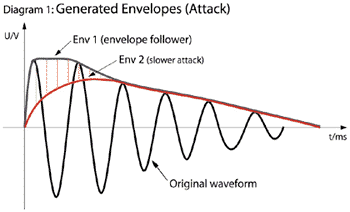
The usage is simple. Insert the effect in your signal chain. Feed in a drum loop. The attack parameter makes the sound sharper or quieter, and the sustain parameter makes the individual drum hits longer or shorter.
Turning up the attack parameter may greatly enhance the attacks in your signal, so the output may contain loud 'pops' at the beginning of sounds. Therefore you may want to insert a limiter or distortion in the signal chain after the transient designer, to keep the signal level reasonable.
The transient designer is best used on drum sounds or drum loops, but the effect greatly depends on the dynamics of the input signal.
A static delay of 3.29 milliseconds is imposed on the processed signal (145 samples at 44100Hz sampling rate, scaled accordingly if sampling rate changes). If you want to mix the processed signal with the original, you may want to delay the original signal by this amount.
| MasterGain | The master gain controls the output level of the effect. If bypass is enabled, master gain has no effect on the signal. |
| Bypass |
Bypass can be set in one of three modes:
To force the machine to be in stereo mode, you can run your mono signal through a stereo effect (such as an ld mixer or a panning effect) first. |
| Attack | Attack specifies how much the attacks of transients in the signal are enhanced. Higher attack means the transients in the signal are made louder, and negative attack makes the transients quieter. See section 2 for more details. |
| Sustain | The sustain parameter affects the decay of sounds in the input signal. If the sustain parameter is set positive, decaying sounds are made louder, and vice-versa. See section 2 for more details. |
| Atck.Shape | The attack shape parameter changes the speed at which the transient designer reacts to attack phases in incoming sounds. If the parameter value is low, the resulting processed attacks are softer and slower than if the value of this parameter is set high. |
| Sus.Shape | The sustain shape parameter affects how the transient designer processes the sustain phase of incoming signals. See section 2 for more information about this parameter. |

The signal is processed by two envelope detectors, and the difference of these detectors is used to enhance the amplitude of the attack of the signal.
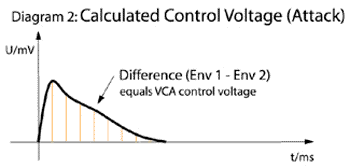
The resulting difference envelope modifies the input signal directly. If the attack parameter is positive, the signal is amplified, and if negative, attenuated.
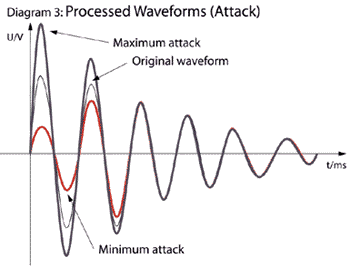
The attack shape parameter affects the speed of the slower of the two envelope followers, making the attack difference envelope harder or softer.
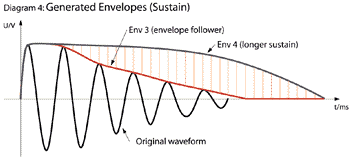
The difference of the two envelopes is again used to modify the amplitude of the input signal.

If the sustain parameter is positive, the decay in the signal is amplified by the sustain envelope (made louder - less decaying), and if negative, the decay is attenuated (made quieter - faster decaying).
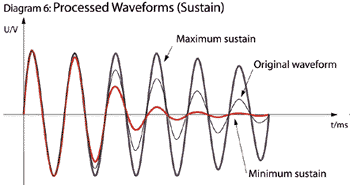
The sustain shape parameter affects the slower of the two envelope detectors, so the sustain effect is made harder of softer.